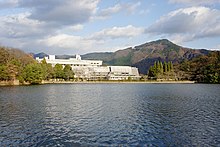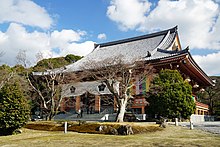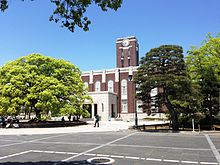
Kyoto, officially Kyoto City, is the capital city of Kyoto Prefecture in the Kansai region of Japan's largest and most populous island of Honshu. As of 2020, the city had a population of 1.46 million, making it the ninth-most populous city in Japan. More than half (56.8%) of Kyoto Prefecture's population resides in the city. The city is the cultural anchor of the substantially larger Greater Kyoto, a metropolitan statistical area (MSA) home to a census-estimated 3.8 million people. It is also part of the even larger Keihanshin metropolitan area, along with Osaka and Kobe.
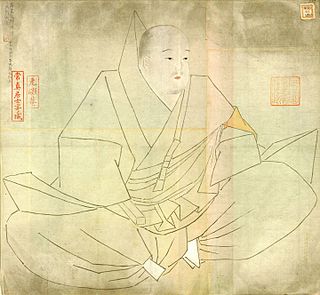
Emperor Shirakawa was the 72nd emperor of Japan, according to the traditional order of succession.

Kyoto-kawaramachi Station is the northern terminal station of the Hankyu Kyoto Main Line of Hankyu in Kyoto City, Japan.

Gion (祇園) is a district of Higashiyama-ku, Kyoto, Japan, originating as an entertainment district in the Sengoku period, in front of Yasaka Shrine. The district was built to accommodate the needs of travellers and visitors to the shrine. It eventually evolved to become one of the most exclusive and well-known geisha districts in all of Japan. Gion is the Japanese translation of the Buddhist term Jetavana. Yasaka Shrine, located in this district is the center of the Gion faith.

Yasaka Shrine, once called Gion Shrine, is a Shinto shrine in the Gion District of Kyoto, Japan. Situated at the east end of Shijō-dōri, the shrine includes several buildings, including gates, a main hall and a stage. The Yasaka shrine is dedicated to Susanoo in the tradition of the Gion faith as its chief kami, with his consort Kushinadahime on the east, and eight offspring deities on the west. The yahashira no mikogami include Yashimajinumi no kami, Itakeru no kami, Ōyatsuhime no kami, Tsumatsuhime no kami, Ōtoshi no kami, Ukanomitama no kami, Ōyatsuhiko no kami, and Suseribime no mikoto.

The Kamo River is located in Kyoto Prefecture, Japan. The riverbanks are popular walking spots for residents and tourists. In summer, restaurants open balconies looking out to the river. There are walkways running alongside the river, and some stepping stones that cross the river. The water level of the river is usually relatively low; less than one meter in most places. During the rainy season, however, the walkways sometimes flood in their lower stretches.
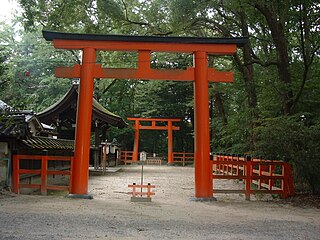
Kamo Shrine is a general term for an important Shinto sanctuary complex on both banks of the Kamo River in northeast Kyoto. It is centered on two shrines. The two shrines, an upper and a lower, lie in a corner of the old capital which was known as the "devil's gate" due to traditional geomancy beliefs that the north-east corner brought misfortune. Because the Kamo River runs from the north-east direction into the city, the two shrines along the river were intended to prevent demons from entering the city.

Higashiyama is one of the eleven wards in the city of Kyoto, in Kyoto Prefecture, Japan.

Kawaramachi Street runs parallel to the west bank of the Kamo River on the eastern side of Kyoto, Japan. Its intersection with Shijō Street is called Shijō Kawaramachi and is a leading shopping district of the city.

Minami is one of the eleven wards in the city of Kyoto, in Kyoto Prefecture, Japan. Its name means "South Ward." It was established in 1955 when it was separated from Shimogyo-ku. As of April, 2016 the ward has an estimated population of 100,781 people. The Kamo River and the Katsura River flow through the district. It is home to several historical places and temples.

Nakagyō-ku (中京区) is one of the eleven wards in the city of Kyoto, in Kyoto Prefecture, Japan. Its name means "central capital ward."

Nishikyō-ku (西京区) is one of the eleven wards in the city of Kyoto, in Kyoto Prefecture, Japan. Its name means "west capital ward" and it is situated on the western edge of the city, to the south of center. The ward was established on October 1, 1976, after it was separated from Ukyō-ku. The Katsura River is the border between Nishikyo-ku and Ukyo-ku.

Shijō Kawaramachi (四条河原町) is a vibrant part of central Kyoto, Japan where Shijō and Kawaramachi Streets intersect. Kawaramachi Street runs parallel to the Kamo River on the eastern side of Kyoto, while Shijō Street runs east–west through the center of the city.

Shijō Street runs in the center of Kyoto, Japan from east to west through the commercial center of the city. Shijō literally means Fourth Avenue of Heian-kyō, the ancient capital.

Kitaōji Station is a railway station on the Kyoto Municipal Subway Karasuma Line in Kita-ku, Kyoto, Japan.

Kokusaikaikan Station is a train station on the Kyoto Municipal Subway Karasuma Line in Sakyō-ku, Kyoto, Japan. It is the beginning of the line, and was opened on 3 June 1997.
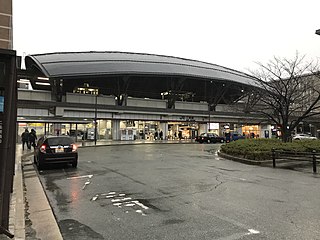
Nijō Station is a train station in Nakagyō-ku, Kyoto, Japan.

Gion-Shijō Station (祇園四条駅) is a railway station on the Keihan Main Line in Higashiyama-ku, Kyoto, Japan, operated by the private railway operator Keihan Electric Railway.

Oike Street is a major street that crosses the center of the city of Kyoto from east to west, running approximately 4.9 km from Kawabata Street (east) to Tenjingawa Street (west).
Sanjō Street is a major street that crosses the center of the city of Kyoto from east to west, running from Shinomiya in the Yamashina-ku ward (east) to the vicinity of the Tenryū-ji in Arashiyama (west).






